The UEFA Champions League is back after the international fixtures. This is the third game of the group and SK Slavia Prag played against Barcelona at the Sinobo Stadium. The home team had been producing dominant performances in domestic competition. Their only defeat this season came from Borussia Dortmund’s game. Jindřich Trpišovský’s tactics were praised and they also played their own style of football against Barcelona.
Barcelona secured a three-nil victory in SD Eibar’s home ground. Ernesto Valverde also treated this game seriously, playing the strongest team in the Czech Republic. The return of Lionel Messi in recent weeks gave Barcelona a lot of positives.
In this tactical analysis, we will show you the tactical battle between Slavia and Barcelona, and how these tactics resulted in Barcelona’s victory.
Lineups
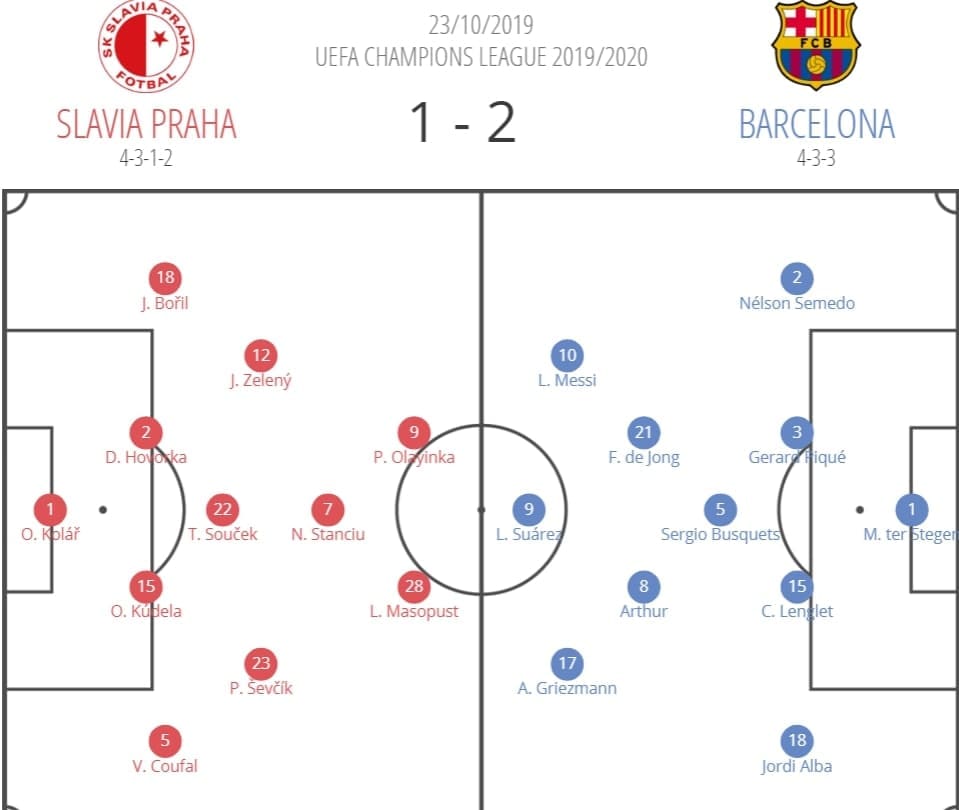
Trpišovský’s team started in a 4-3-1-2 formation. Tomáš Souček, the skipper is currently the top scorer of Slavia in domestic competition. 29-year-old midfielder Josef Hušbauer has rotated again in the Champions League, while Petr Ševčík and Souček played together in the midfield. Their Nigerian striker, Peter Olayinka scored six goals this season, and he also started.
With the return of Messi, he formed the front three with Suárez and Antoine Griezmann. Sergi Roberto was injured in the La Liga game so Nélson Semedo played at the right side of the defence. Samuel Umtiti was once again injured, and Clément Lenglet partnered with Gerard Piqué at defence. The rest were all started in the game against Eibar. Valverde’s team played in a 4-3-3 formation.
Intriguing defence of Slavia
Slavia’s defence was interesting. Instead of defending with an organized and stable defensive shape, their players always leave their positions to cover each other. Slavia players man-marked their opponents tightly, but it seems that they hardly marked the same target all the time given the frequently rotated positions of Barcelona. Therefore, sometimes it was a back four, and it could turn to a back five or even a back six at the defence.
Since Slavia’s system required their players to step out early, their midfielders or even front players also involved heavily in the defence.
The below image is an analysis that helps illustrated Slavia’s defence. The Barcelona front three pinned the Slavia back four wisely. Messi, Suárez and Griezmann all stayed between players, this confused the oppositions that who should take care of them. In response to this, Slavia’s midfielders dropped to the defensive line to cover spaces and prevented their backline further stretched by Barcelona. However, this also left the midfield free with space, encouraged the opposition front three to drop and receive the ball.
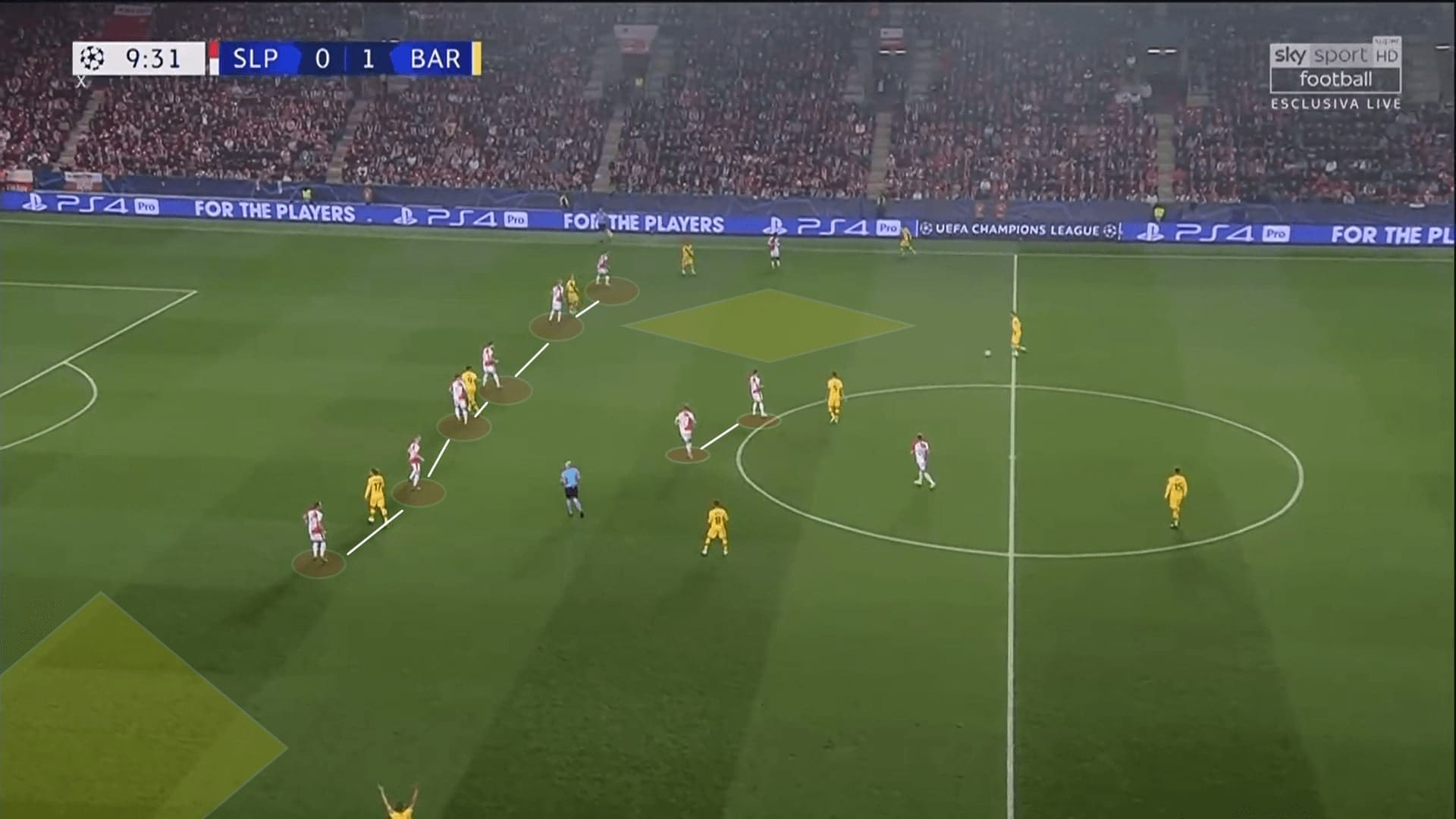
The above scene also demonstrated an attacking approach of Barcelona. When they kept the ball in the build-up phase and the oppositions formed the low block, they utilized the wide spaces. Piqué was the centre-back who provided diagonal balls to find Jordi Alba. When Griezmann stayed at the half-spaces and forced Slavia to stay in a narrow shape, Alba pushed forward to provide the width.
Barcelona’s penetration
Barcelona possessed with technically gifted players who can play penetrating passes, including their defenders. Apart from diagonal balls to find Alba, Piqué also played vertical passes to penetrate. Barcelona’s attack also emphasized on the dropping movements of players. As mentioned, Slavia players stepped out very early to follow their man which resulted in lose shape, this gave spaces for Barcelona to penetrate.
The scene reflected the capability of Piqué to start an attack. Messi dropped to the midfield, Semedo stayed on the touchline to provide some widths. Since Messi took the Slavia midfield away from position and no player was tracking Semedo, the Portuguese right-back was totally free. Meanwhile, Frenkie De Jong stayed at the half-spaces, pinned Jan Bořil, spaces generated at the flank.
The situation could be eased if a Slavia player closed off Piqué to force him from deciding quickly. In this case, Slavia’s defensive line pushed high to stay in a compact shape vertically. Piqué found the gap between Slavia players and he hit that space, Semedo received the ball and got huge rooms to carry the ball.
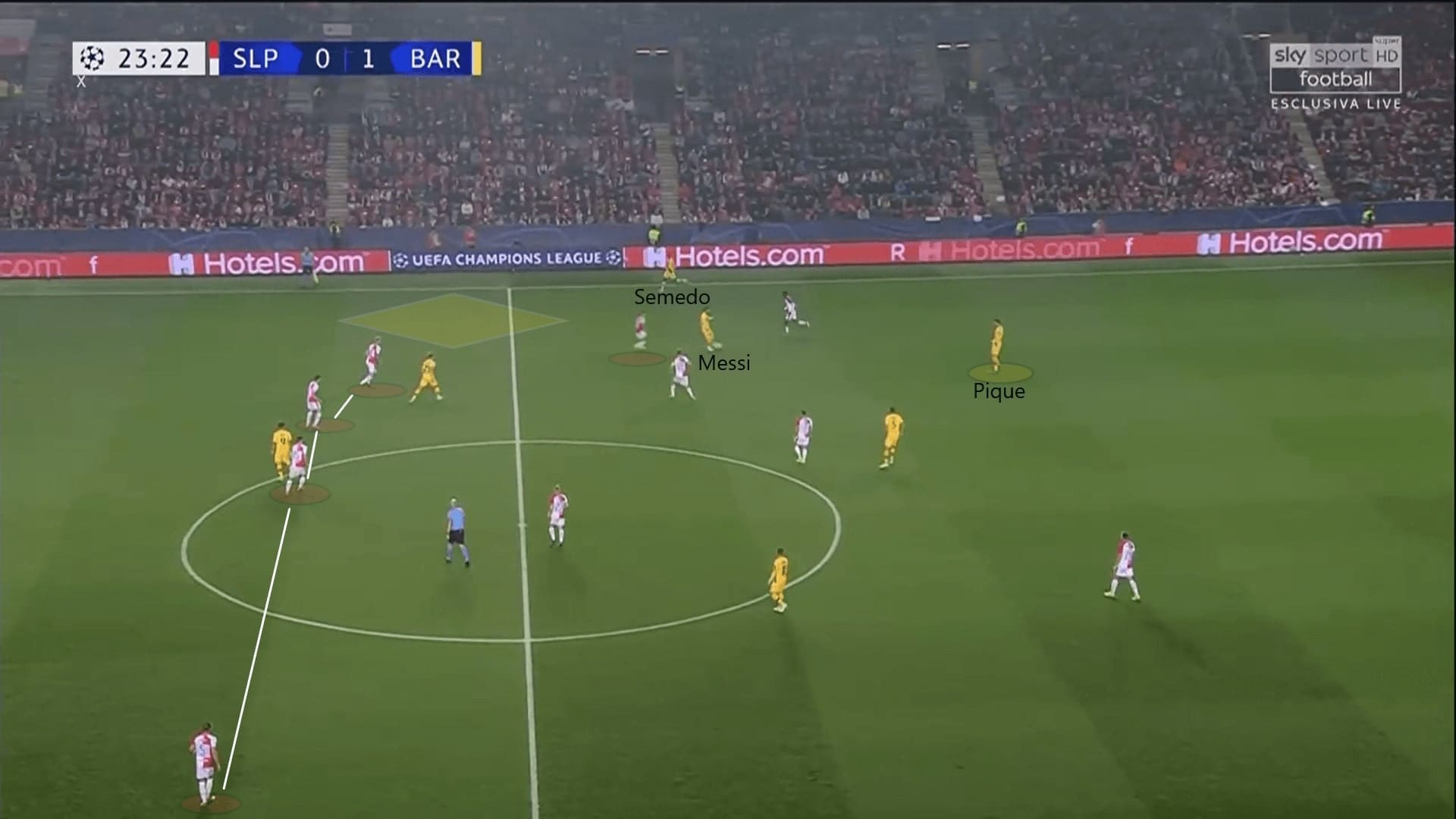
The below scene is another example. Slavia kept their defensive shape compact horizontally, as the Barcelona front three stayed narrow to pin the defenders again. Once again, we saw Semedo, the Portugal right-back running towards the right flank, and Piqué could pick him. Slavia midfielders should have done better to close off or mark Barcelona players when defending in the midfield.
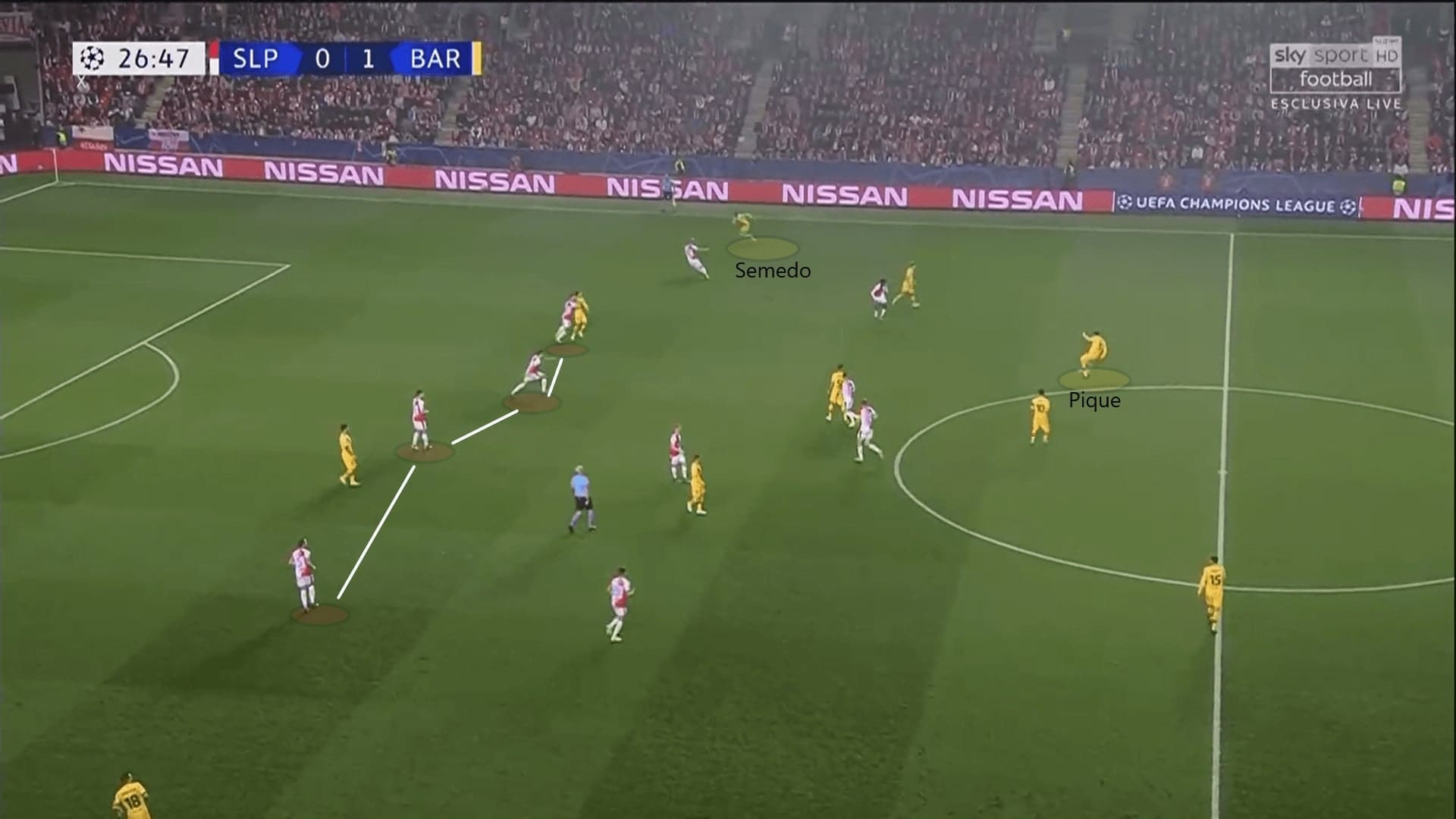
Apart from starting the attack on the right, Barcelona also tried an attack from the left. They did enough to put Slavia defenders in a dilemma. The home team must choose whether staying in their positions to maintain the shape or stay wider to anticipate a pass. Therefore, sometimes they were caught.
This was a case Slavia could have done better. Alba’s positioning, high and wide forced Vladimír Coufal to stay wider. It increased the distance between the right-back and Ondřej Kúdela. At this moment, it required Lukáš Masopust to cover the gap, which the no.28 failed to defend with appropriate body orientation. This limited his angle of defend and Lenglet could still find Griezmann with this gap.
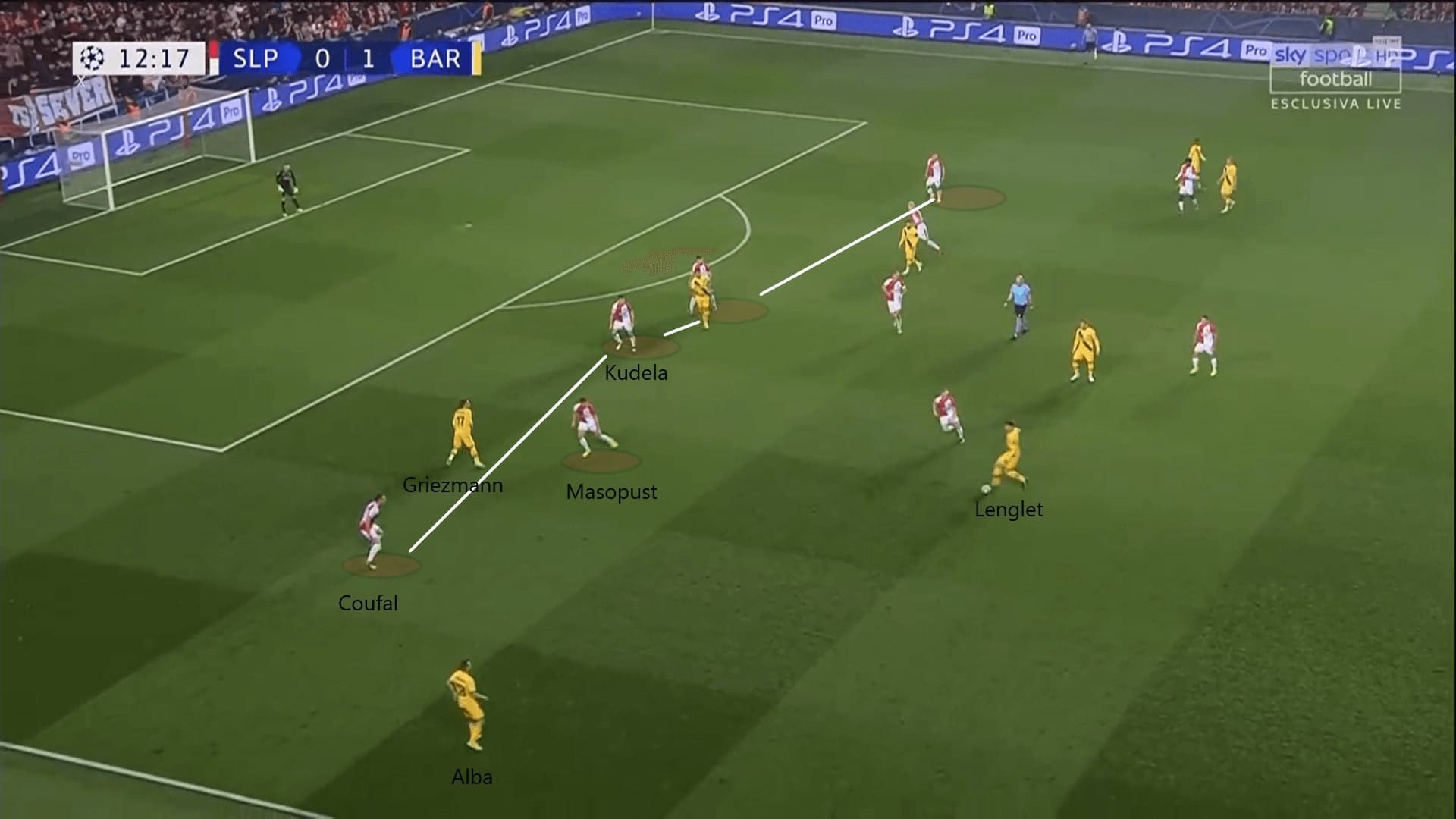
Barcelona’s counter-press
Despite the way Barcelona attack mentioned, their biggest chance and Messi’s goal were from a quick counter. This could be attributed to the good counter-press performed by the away team in the early stages. Slavia did not register their first shot before 20 minutes.
We chose the below scenes as an example. This was the situation where Barcelona’s attack failed to progress, and they lost the ball in Slavia’s final-third. At this moment, it was a three on three situations in the red-highlighted region.
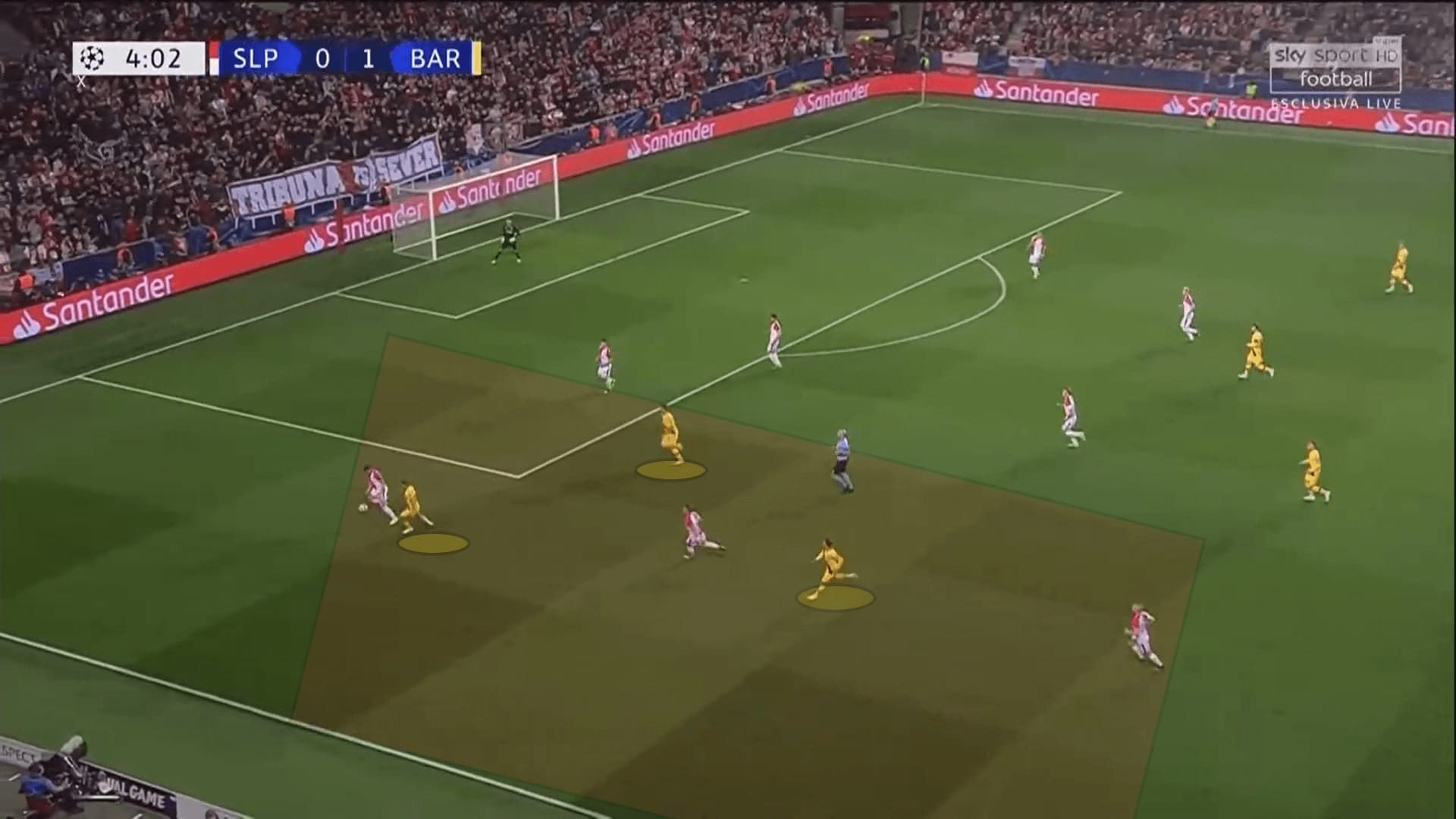
After just seven seconds, the situation was totally different, which Barcelona committed numbers in their counter-press. First, we saw four yellow shirts surrounded two Slavia players, including the ball-carrier. Second, their pivot Sergio Busquets also marked the free player out of the Barcelona’s defend area. Praises should be given to Barcelona since they even allowed their centre-back Lenglet to join the high press. In this counter-press, Barcelona won the ball back.
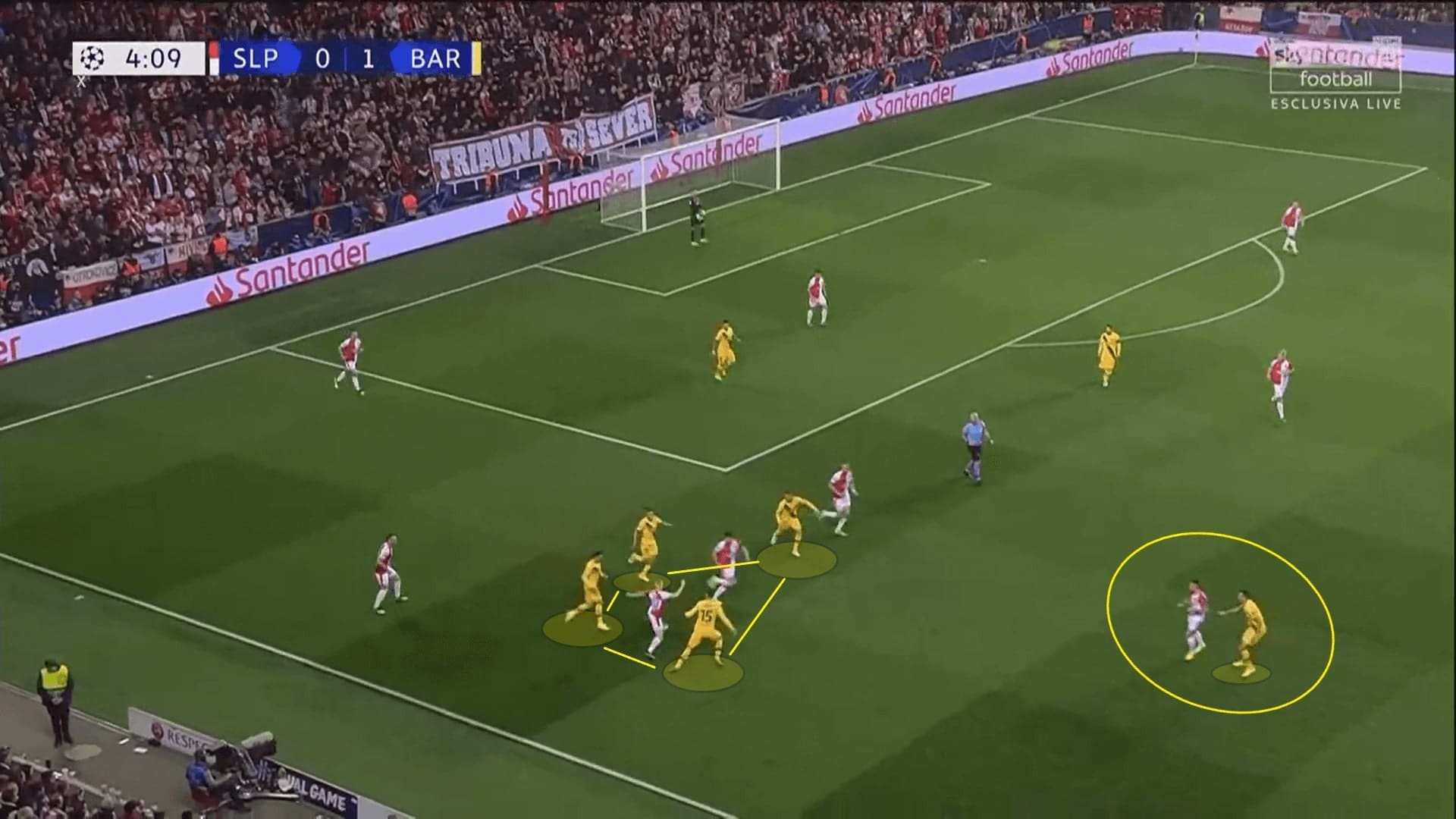
Barcelona’s first goal was also attributed to the counter-press, which Messi anticipated and intercepted the pass in the final third. However, both the Argentine and Suárez was 32 already, they could not participate in the intense counter-press throughout the whole match. Barcelona’s counter-press did not sustain.
Slavia were well prepared offensively
The home team prepared enough to deal with the press of Barcelona. As mentioned, Messi and Suárez had very light defensive responsibilities in this match. This forced Valverde to instruct the rest to run more and close off opponents. Arthur was the player who stepped out a lot to press in this match. However, Slavia gained an advantage from the space behind Arthur.
The below scene was an example, which attributed from an unorganized high block of Barcelona. Both Griezmann and Arthur stepped out to cooperate with the press. Slavia keeper Ondřej Kolář’s passed to eliminate the two found Coufal. Alba was in trouble as the three Slavia players overloaded the area. Busquets could not rescue too early as another Slavia player occupied the centre. Slavia could start their attack through space behind Arthur.
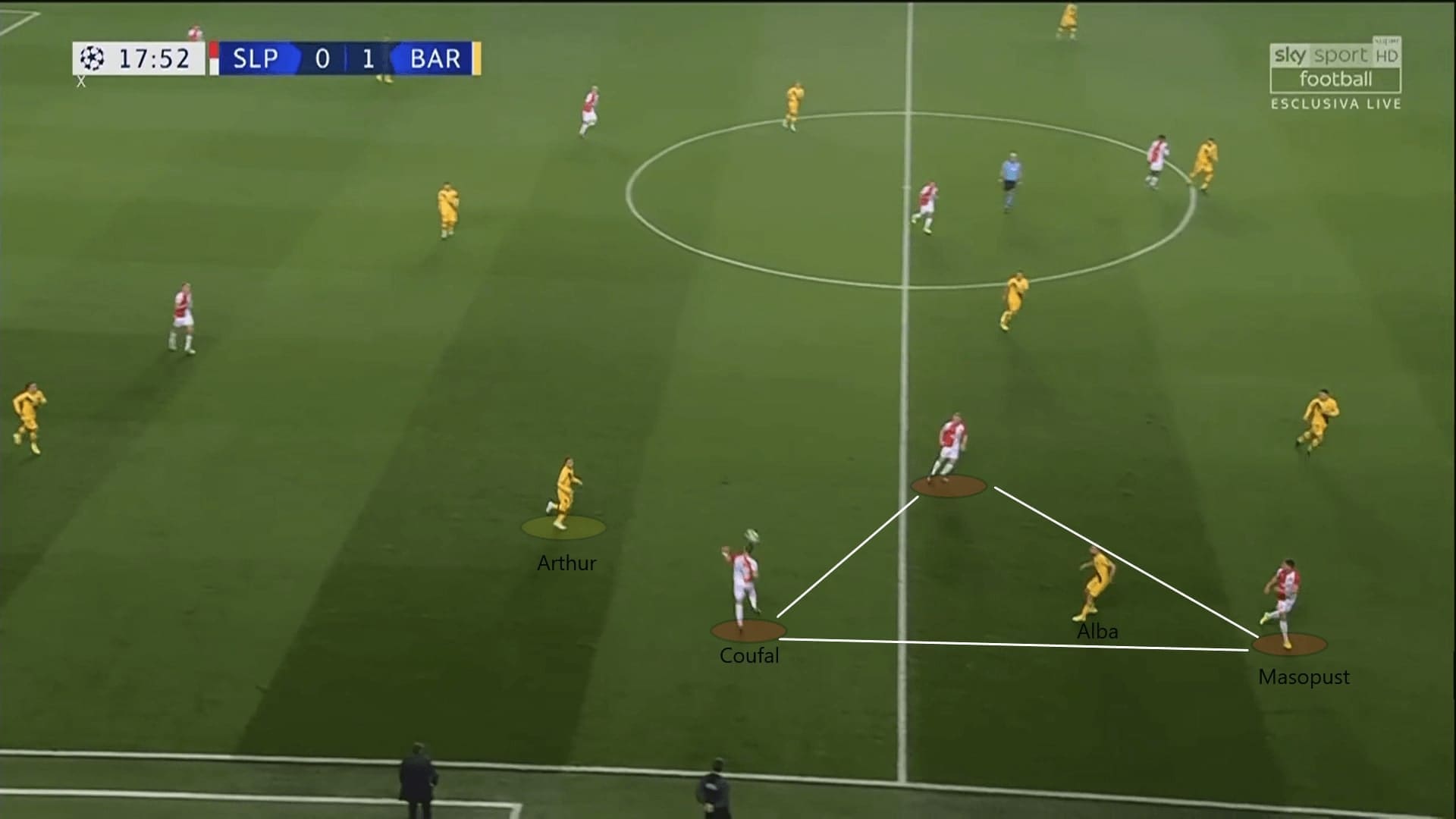
When Slavia entered the final-third, they also capitalized on Messi’s and Suárez’s positioning. These two players had the freedom to defend less. However, these left Barcelona to defend in an asymmetrical 4-4-2, wide areas without protection.
As the below situation reflected, there are a few problems for Barcelona. First, they did not have enough players to cover the wide spaces, preventing Slavia from crossing in a favourable condition. In the box, the centre-backs were left in a two v three situation, while Alba was overloaded. No midfielders could provide additional protection to the box. Barcelona were fragile if the Slavia player attempted a cross.
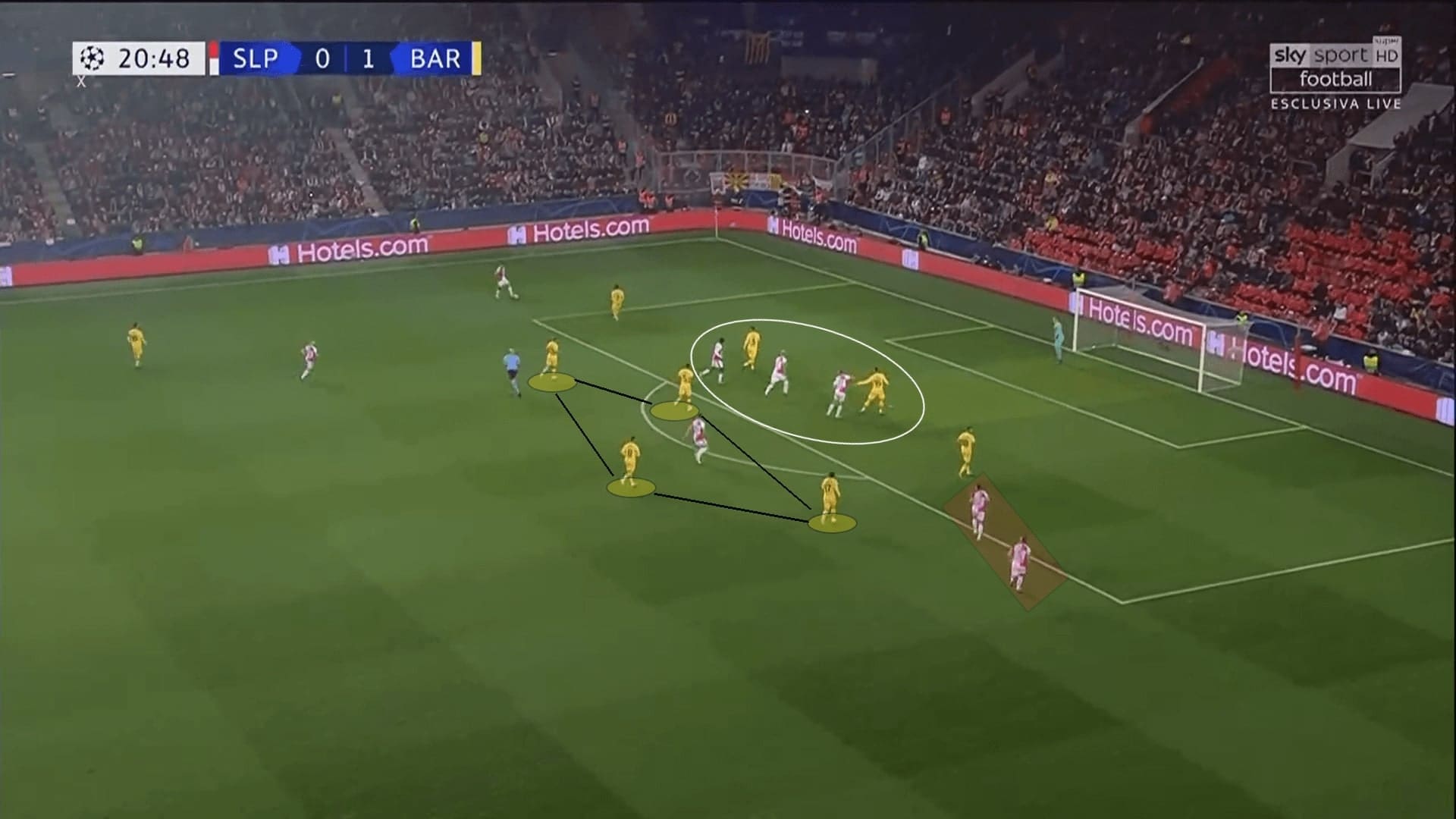
Slavia exploited spaces behind Barcelona midfielders
After the break, Slavia attacked sharper. They found the defensive weaknesses of Barcelona. Given the low defensive duties of Suárez and Messi, Barcelona midfielders had to run and press more, especially in a high line of defence. Slavia did not only get behind Arthur. Instead, they drew Busquets out of positions also. They were not quick enough to cover the space behind them. This created some problems for Barcelona.
As shown below, the Alba and two midfielders defended together at the midfield. However, the rest of the defenders did not step up to cooperate, which left huge spaces between and behind them. Meanwhile, Alba left his position so the left of the Barcelona defence was also fragile.
In this case, Ševčík could get behind the midfielders. Then, he got plenty of time to carry the ball, distributed it to Masopust, who was free with space on the right. Barcelona could not deal with it.
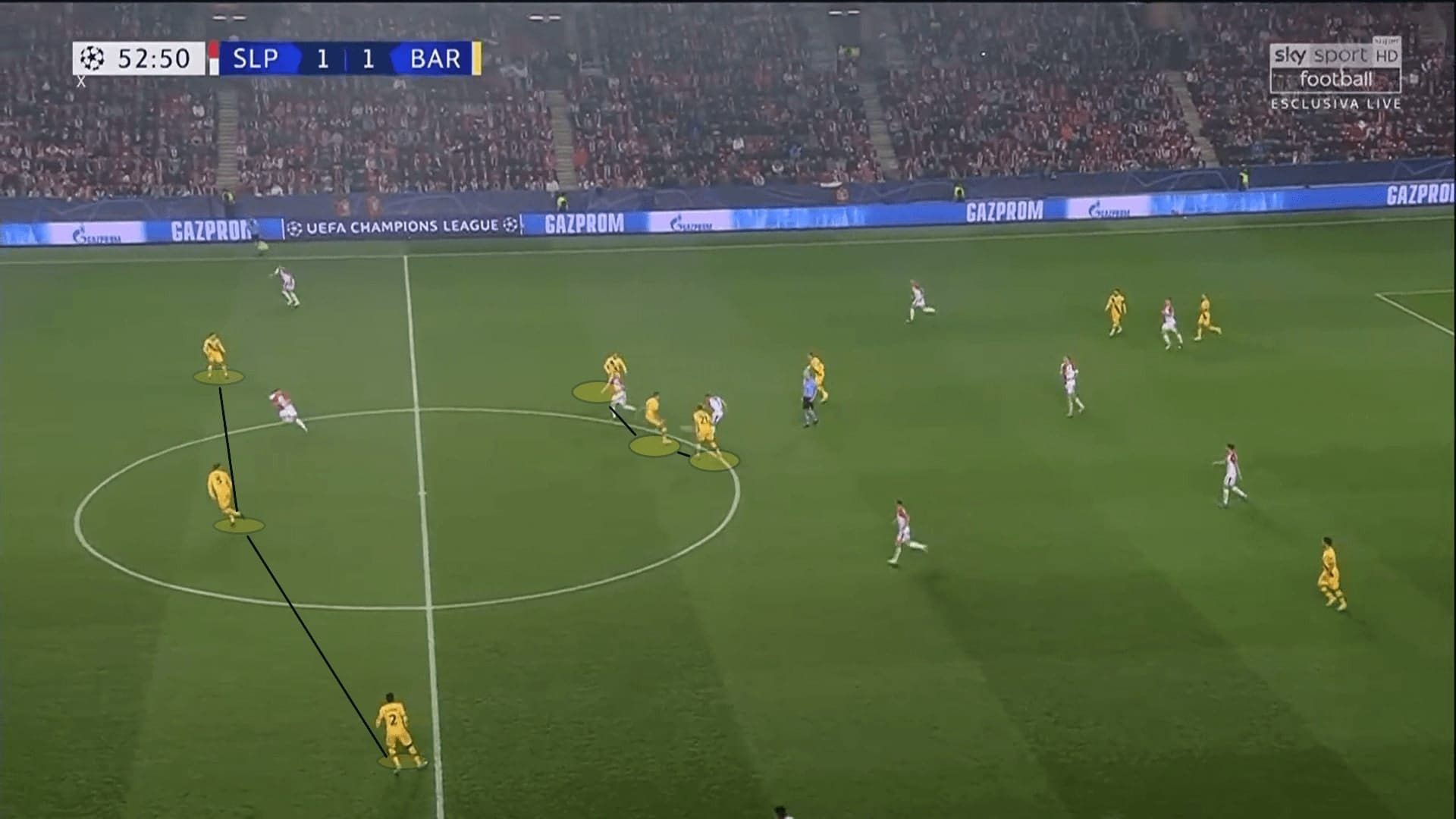
The below case was how Slavia capitalized from those space and scored a goal. Barcelona always lost shape when defending, and their defenders failed to cooperate the high press for most of the time.
In this scene, Arthur, De Jong and Busquets stepped out again. The positioning of the Spaniard was vital as he as the only the pivot to stay in front of the defenders. Since the low defensive duties of Messi, Busquets had to step out and cover the midfielder. This left the Barcelona defence exposed.
Piqué was pinned, and Semedo was overloaded by two players. A long ball to hit space behind them could harm Barcelona. Bořil, the left-back, played long, then dashed forward immediately. De Jong was unaware of the movement of the left-back, and he did not track him. Therefore, Bořil became the free man to pick the pass and shoot in the box. Again, this happened at the right side of the defence, Messi’s side. Barcelona were not comfortable to deal with the players.
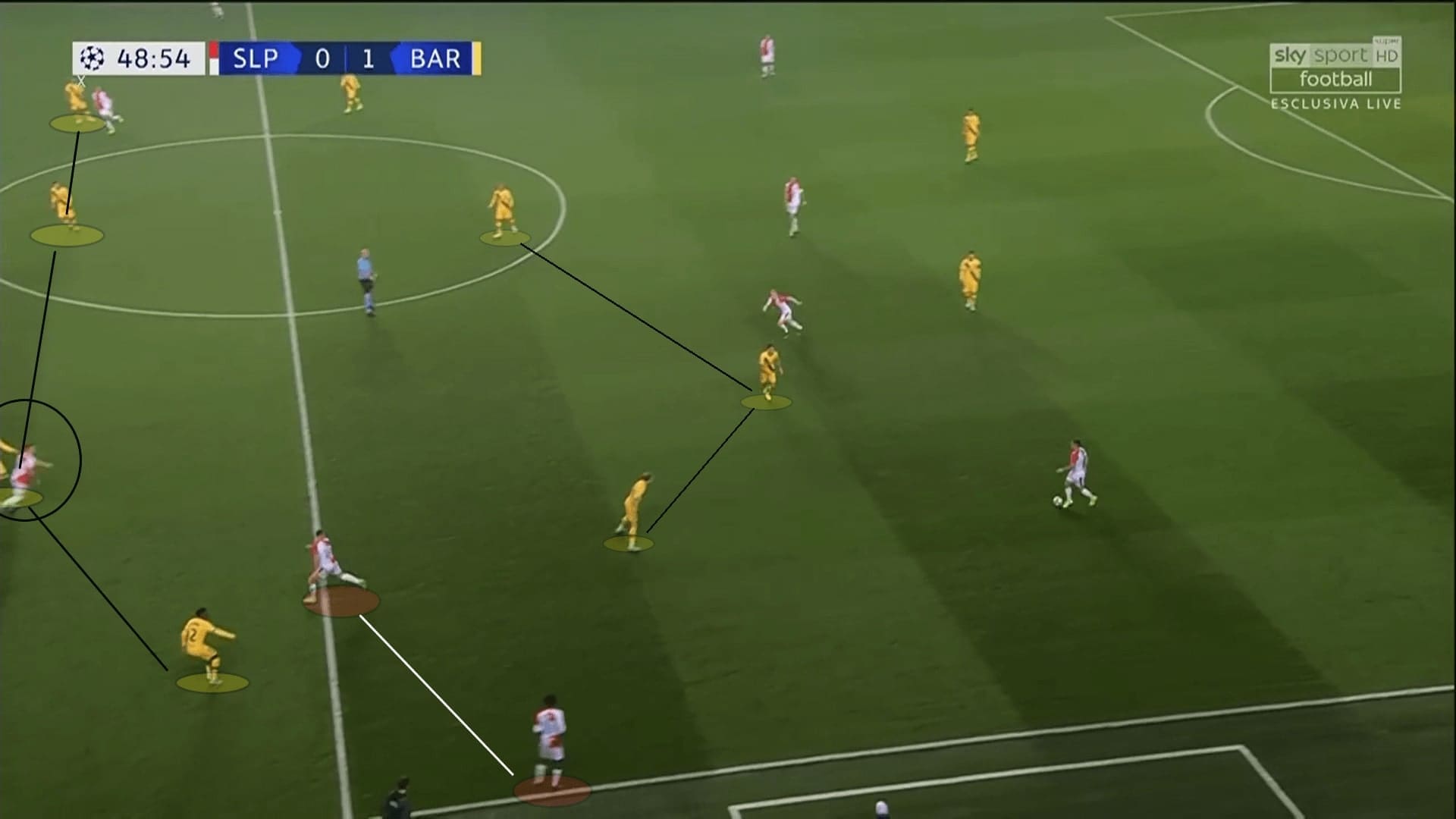
Conclusions
To conclude, Slavia played well and in their own style of football. This explained why they performed so well in domestic competitions, they were confident. Furthermore, they were well prepared for the game and they can hit the weaknesses of Barcelona. Every team visits to the Czech should found themselves playing difficultly.
Meanwhile, though Barcelona secured a win, there were issues yet to be addressed. Valverde should find a balanced solution to assign the defensive duties of front players, Barcelona lost shape too often in the game.

If you love tactical analysis, then you’ll love the digital magazines from totalfootballanalysis.com – a guaranteed 100+ pages of pure tactical analysis covering topics from the Premier League, Serie A, La Liga, Bundesliga and many, many more. Buy your copy of the October issue for just ₤4.99 here





Comments